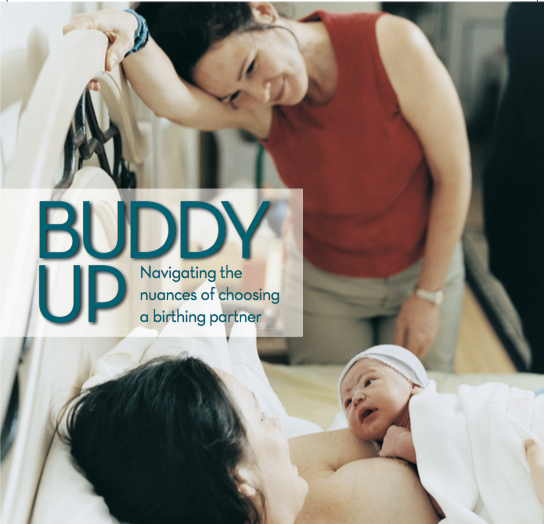
 You know exactly what you want to pack in your birthing bag, but do you know who you want carrying it into L&D for you? These days, many moms are taking doulas and midwives into labor and delivery rooms. They’re also bring their mothers, sisters, best friends, and even their own fathers with them. And this isn’t something new. Ancient Malaysians and Indonesians gathered all the mothers in the family or community around a woman in labor, while Navajos would often have members of the community chant and sing “unraveling” songs to speed labor along.
You know exactly what you want to pack in your birthing bag, but do you know who you want carrying it into L&D for you? These days, many moms are taking doulas and midwives into labor and delivery rooms. They’re also bring their mothers, sisters, best friends, and even their own fathers with them. And this isn’t something new. Ancient Malaysians and Indonesians gathered all the mothers in the family or community around a woman in labor, while Navajos would often have members of the community chant and sing “unraveling” songs to speed labor along.
“During the most intimate time of their life, women need support beyond what their doctors, and often their husbands, can offer during labor and delivery,” says Leslie Ludka, M.S.N., senior technical advisor at the American College of Nurse-Midwives and a certified nurse-midwife who has attended the births of nearly 4,000 babies. That all sounds lovely, but are you really up for having a standing room–only crowd in the delivery room? Read on to find out.
Why Draft a Team?
Many dads are uncomfortable in the delivery room. They don’t want to see their wives in pain, or they can’t handle the sight of blood and needles. “A dad’s comfort level in the delivery room is not a measure of his love or commitment to his family,” says Breck Hawk, R.N., a midwife in San Diego, CA, and author of Hey! Who’s Having This Baby Anyway?, “but it’s often a factor in women bringing another person into the room.”
Even if he has a stomach for pain and hospital food, it’s hard for a man to understand the emotions, sensations, and experiences a woman experiences during labor and delivery. “That’s why many moms-to-be also choose to bring a female counterpart in with them. They’re comforted by having someone who’s either “been there” or who’s shared other milestones with them,” Hawk says.
Like you, a dad-to-be is anxiously waiting to count 10 tiny fingers and toes. “That anxiety can inadvertently divert his attention away from tending to your needs,” Hawk says. Having someone there just for you helps you to “let go” of distractions, because you know your needs will be taken care of. A birth buddy also lets dad take a food or bathroom break without feeling he’s choosing between caring for you and taking care of himself. “A refreshed father can be an invaluable asset to a woman in labor,” Hawk notes.
 Who gets the nod?
Who gets the nod?
Hiring a doula or midwife to be with you—in addition to your obstetrician—is one option. “A doula provides physical and emotional assistance before, during, and/or after childbirth based on your preferences,” Ludka says. You can usually find one through referrals either from other new moms, your doctor, a birthing center, or
dona.org.
Your circle of family and friends is another place to look for a birth buddy. But asking a family member or friend to join you in the delivery room isn’t at all like hiring a doula. “Doulas and midwives can be formally interviewed and screened,” Ludka says. Your best friend probably doesn’t have a list of five references for prior births she’s attended.
But that doesn’t mean you can’t ask some questions. To narrow your search, assess how your potential birth coach handles stressful situations. How does he or she react to you in emotionally charged settings? “Trust your instincts,” Ludka says. Ask yourself if the person will support your decisions, even ones that change during labor or are decisions she might not have made for herself. Pick someone who won’t pass judgment. “If you want an epidural, don’t bring a friend who will lecture you about her disapproval of them,” Ludka says.
It is a good idea to bring someone you know can stay cool in stressful situations. “You want to focus on your labor, not trying to be happy or avoid upsetting someone else,” Moore says, “Everyone in the room should be there to help you, not for you to worry about them.”
Once you’ve compiled your “short list” of possible birth partners, approach candidates about a playing a role in your delivery in a manner similar to the way you would interview a doula. Ludka says, “Do this weeks or even months before your due date to have time to find someone who is comfortable being part of a vulnerable and intimate moment.”
Talk about their comfort level with parts of your body being exposed during labor and birth. Don’t bring anyone in the room who will be embarrassed by this, or who you’ll be embarrassed in front of. And don’t be afraid to change your mind. “I have seen many women initially refuse having their mother in the room, but then ask for her a few hours into labor,” says Marianne Moore, R.N., certified nurse midwife at The University of Texas Health Science Center at Houston School of Nursing, in Houston, “or ask someone to leave the room after planning on them being present for the labor and birth.”
Can’t choose between two special people? Ask one to stand by to be sure at least one of them can make it to the birth. Or to ask one person to coach during labor and the other to be with you during delivery and the first minutes of after. “Do whatever feels the most natural and comforting to you,” Moore says.
Thanks, But I’ll Pass
Don’t assume whomever you ask will agree to be present. People say no for a variety of reasons, Ludka says. The delivery room is not a comfortable place for everyone. “We all know our limitations. If someone has reservations and attends anyway, the atmosphere in the room can be affected in a negative way.”
If someone declines being in the delivery room with you, try to be grateful they were honest. “A ‘no’ isn’t a representation of their feelings for you or their level of excitement for your baby,” Ludka says.
Getting Ready to Go
At the birth of her second son, J.J., Schambow, a Menomonee Falls, WI, mom to 1 and 3-year-old sons, hired a doula and asked her sister and sister-in-law to join her and her husband in the delivery room. “We wrote a birth plan and discussed the roles with everyone ahead of time so they all knew their functions,” she says. “Everyone worked like a team and made me feel well-supported. It helped me do what I needed to do. We credit open and direct communication about roles and expectations with everyone’s proactive and supportive attitudes,” Schambow says, “and with our sons’ births being so calm.”
Moore says everyone you choose needs to understand your vision of the birth partners’ roles in the delivery room. “Talk openly and honestly about what you want them to do.” Whether it’s offering supportive words, holding your hand, or wiping your forehead, they need to know your expectations. Moore says, “Even if you just want their presence in the room, tell them where you’d like them to ‘hang-out’ during labor and delivery.”
Share your written or verbal birth plan with your birthing buddy so she can speak up communicate your wishes to the staff if you’re unable to. Discuss and write down your preferences for everything from epidurals and breastfeeding right after delivery, to taking photos, before heading to the hospital. “You’ll avoid any misunderstanding and confusion,” Moore says.
If your birth buddy has never attended a birth, Moore recommends reviewing birth literature and watching a birthing video together so everyone knows what to expect. Ask the leader of your birthing class if you can bring two coaches. “Schedule a tour with everyone you’re planning on having in the delivery room at the birthing unit to familiarize everyone with the facility’s resources such as Jacuzzis, showers, birth balls, rockers, policies on food and fluids, etc.,” Moore suggests.
What to Expect
Birth partner’s roles vary from mom to mom. “One of the most important hats my sister-in-law wore was that of the videographer. It let my husband focus on the moment,” Schambow says.
Birthing teammates can keep the atmosphere calm by just being quietly present, sitting at the bedside, and offering appropriate words of encouragement. They can also provide levity if you’re up for hearing juicy gossip, keep you focused on your breathing during each contraction, or provide hourly phone or email updates to family members and friends. “They can do virtually any supportive activity that is comforting to the mom,” Hawk reminds.
The Big Day
When you check-in to at your hospital or birth center, Hawk says it’s a good idea to tell the staff who you want in the room with you. Birthing centers and obstetric floors have very tight security and you don’t want a member of your birthing team delayed or blocked from getting to you because the staff wasn’t expecting them.
As your due date draws near, certified nurse midwife Leslie Ludka, M.S.N., senior technical advisor at the American College of Nurse-Midwives says, “Everyone who will be in the delivery room with you should keep a ‘hospital bag’ packed and easily accessible in anticipation of the big day.” Here’s a list of must-have items your team members should stash in their bags:
• Cell phone and charger
• Toothbrush and toothpaste
• A bathing suit, because you never know when a tub or shower is going to be involved
• A full change of clothes including socks, shoes, and underwear. Your partner may wind up in the shower with you or wanting to freshen up for photos.
• Over-the-counter headache and antacid medication, plus any prescription medications (inhalers, and so on)
• High-energy snacks, such as trail mix, and bottled water. Just make sure
the snacks don’t have strong smells because mom may not tolerate the
odor or crunching.
— Gina Roberts-Grey
Her pre-term labor and delivery meant author Gina Roberts-Grey’s room was off limits to extras. If she could have asked someone to join her and her husband, she would have asked her grandmother to be with her.


Leave a Reply